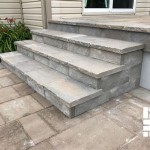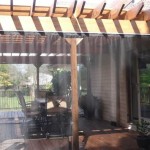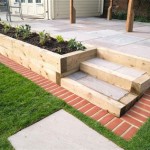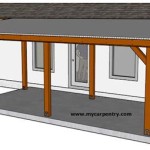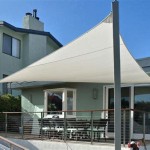How To Fix Old Cement Patio Slabs
Old cement patio slabs, while durable in many respects, are susceptible to a range of issues over time. Weathering, settling, and general wear and tear can lead to cracks, uneven surfaces, and an overall unsightly appearance. Restoring these slabs can be a cost-effective alternative to complete replacement, extending the lifespan of the patio and enhancing its aesthetic appeal. This article provides a comprehensive guide to diagnosing common problems and implementing effective repair strategies for old cement patio slabs.
Diagnosing Common Patio Slab Problems
Before embarking on any repair project, a thorough assessment of the patio slab's condition is crucial. This involves identifying the types of damage present and understanding the underlying causes. Different issues require different approaches, and an accurate diagnosis will ensure the correct repair methods are employed.
One of the most common problems is cracking. Cracks can range from hairline fractures to wide, deep fissures. Hairline cracks are often cosmetic and may not require immediate attention. However, wider cracks can allow water to penetrate the slab, leading to further deterioration through freeze-thaw cycles (in colder climates) or corrosion of any embedded reinforcement. These cracks also provide pathways for weeds and insects, exacerbating the damage.
Uneven surfaces are another frequent issue. Settling of the soil beneath the slabs can cause them to tilt or sink, creating tripping hazards and drainage problems. This settling can be caused by soil erosion, poor compaction during the initial construction, or tree root encroachment. In some cases, the slab itself may be fractured, leading to a localized dip or rise.
Spalling, which refers to the surface deterioration of the concrete, is also common in older patios. This can manifest as flaking, pitting, or crumbling of the concrete surface. Spalling is typically caused by exposure to de-icing salts, freeze-thaw cycles, or chemical attack. It exposes the aggregate within the concrete and can weaken the slab's structural integrity.
Discoloration and staining are primarily aesthetic concerns, but they can detract from the patio's appearance. Stains can be caused by a variety of factors, including rust, mildew, algae, and spilled liquids. Discoloration may also result from variations in the cement mix or uneven curing of the concrete during the original construction.
Finally, joint issues can arise. The joints between patio slabs are designed to allow for expansion and contraction due to temperature changes. Over time, these joints can become filled with debris, damaged, or improperly sealed, leading to water infiltration and further problems.
Repairing Cracks in Patio Slabs
Addressing cracks in patio slabs is essential to prevent further damage and maintain the patio's structural integrity. The repair method depends on the width and depth of the cracks.
For hairline cracks (less than 1/8 inch wide), a concrete crack sealant or patching compound can be used. The process involves cleaning the crack thoroughly with a wire brush and removing any loose debris. A concrete crack sealant, applied with a caulking gun, will prevent water from entering the crack. The sealant should be flexible enough to accommodate future expansion and contraction. Following the sealant application, a patching compound can be applied to create a smooth, level surface. The compound should be troweled to match the surrounding concrete and allowed to cure according to the manufacturer's instructions. The use of a concrete bonding agent can aid in the proper adhesion of the patching compound to the original slab surface.
Wider cracks (greater than 1/8 inch) require a more involved repair process. First, the crack must be widened and deepened using a chisel and hammer. This creates a larger surface area for the repair material to adhere to. The crack should then be thoroughly cleaned, removing all loose debris and dust. A concrete bonding agent should be applied to the inside of the crack to promote adhesion. Next, a non-shrink concrete patching compound or a concrete repair mortar should be mixed according to the manufacturer's instructions. The material should be packed tightly into the crack, ensuring that it fills the entire void. The surface should then be troweled smooth and allowed to cure. It is crucial to keep the repaired area moist during the curing process to prevent cracking.
For particularly large or deep cracks, it may be necessary to use a concrete crack injection system. These systems involve injecting an epoxy or polyurethane material into the crack under pressure. The material penetrates deep into the crack, filling all voids and bonding the concrete back together. This method is typically used for structural repairs or when the crack extends through the entire thickness of the slab. This is a more complex method of repair and may require the assistance of a professional.
Leveling Uneven Patio Slabs
Addressing uneven patio slabs requires identifying the cause of the settling and implementing a solution to raise the sunken slab. Several methods can be used, depending on the severity of the settling and the underlying soil conditions.
For minor settling (less than 1 inch), a process called "mudjacking" or "slabjacking" can be employed. This involves drilling small holes through the sunken slab and injecting a grout mixture (typically a combination of cement, sand, and water) beneath the slab. The pressure of the grout raises the slab back to its original level. The holes are then patched with concrete. Mudjacking is a relatively quick and cost-effective method of leveling slabs, but it requires specialized equipment and expertise. It is often best to consult with a professional contractor experienced in this technique.
For more significant settling or when the soil conditions are unstable, it may be necessary to remove the affected slab and rebuild the base. This involves carefully breaking up and removing the slab, excavating the underlying soil, and compacting a new gravel base. A layer of sand can then be added to provide a level surface for the new or replaced slab. The new slab can be poured in place or pre-cast slabs can be used. Proper compaction of the base is critical to prevent future settling. A plate compactor should be used to compact the gravel and sand layers.
Another method involves using polymeric sand. Polymeric sand is a specialized sand that contains additives that bind the sand particles together when wetted. This creates a firm, stable surface that can be used to level minor dips and depressions around the edges of slabs. The process involves sweeping the polymeric sand into the joints and cracks around the slab, then wetting it with water. The polymeric sand will harden over time, creating a solid, level surface.
Before embarking on any leveling project, it is crucial to determine the cause of the settling. If the settling is due to soil erosion, it is essential to address the underlying drainage issues to prevent future problems. This may involve installing French drains or redirecting surface water away from the patio area.
Addressing Spalling and Surface Deterioration
Repairing spalling and surface deterioration involves removing the damaged concrete and applying a new surface layer. The extent of the damage will determine the specific repair method.
For minor spalling (less than 1/4 inch deep), a concrete resurfacing compound can be used. The process involves cleaning the surface thoroughly and removing any loose debris. A concrete bonding agent must be applied to assist with adhesion. The resurfacing compound is then mixed according to the manufacturer's instructions and applied to the surface with a trowel. The compound should be feathered out to blend with the surrounding concrete. A textured finish can be applied to match the original surface. The resurfaced area should be kept moist during the curing process.
For more extensive spalling, it may be necessary to remove the damaged concrete down to a sound surface. This can be achieved using a hammer and chisel or a concrete grinder. The exposed aggregate should be thoroughly cleaned. A concrete bonding agent is then applied to the surface. A concrete patching compound or a concrete repair mortar is mixed and applied to fill the damaged area. The material should be troweled smooth and allowed to cure. In some cases, it may be necessary to apply multiple layers of patching compound to achieve the desired thickness.
To prevent future spalling, it is essential to protect the concrete surface from de-icing salts and freeze-thaw cycles. This can be achieved by applying a concrete sealer. A penetrating sealer will help to prevent water from entering the concrete, while a surface sealer will provide a protective barrier against de-icing salts and other chemicals. The sealer should be reapplied periodically, according to the manufacturer's instructions.
Additionally, good drainage practices will help to reduce the risk of spalling. Ensure that water drains away from the patio area and does not pool on the surface. Consider installing gutters or downspout extensions to redirect water away from the patio.
By addressing these issues promptly and effectively, homeowners can significantly extend the lifespan of their old cement patio slabs, maintaining their functionality and aesthetic appeal for years to come.

How To Repair A Patio S Grouting Sinking Checkatrade

How To Repair And Resurface Old Concrete Patios Fixing Ugly

How To Repoint Paving Slabs

Concrete Patio Repair Resurface 5 Stunning Examples Skv Construction

How To Remove Your Concrete Patio Dumpsters Com

Concrete Patching How To Bond Existing For Best Results Sakrete

Diy Ideas To Update Your Worn Out Concrete Patio Outdoor Backyards

5 Ways To Fix Ed Or Damaged Concrete Patio Cricket Pavers

Pouring New Concrete Over Old Slab

How I Made My Patio Look New Again With Olympic Rescue It
Related Posts

